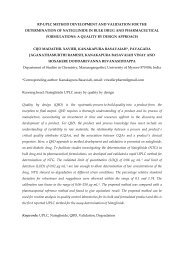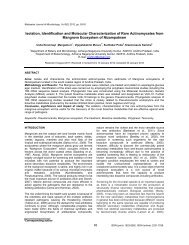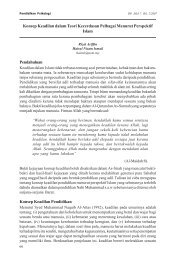"Acceptability" in the Translation into Malay of Rihlat Ibn ... - USM
"Acceptability" in the Translation into Malay of Rihlat Ibn ... - USM
"Acceptability" in the Translation into Malay of Rihlat Ibn ... - USM
You also want an ePaper? Increase the reach of your titles
YUMPU automatically turns print PDFs into web optimized ePapers that Google loves.
"Acceptability" <strong>in</strong> <strong>the</strong> <strong>Translation</strong> <strong>of</strong> <strong>Rihlat</strong> <strong>Ibn</strong> Battutah 13<br />
comb<strong>in</strong>ation as an equivalent to / /, thus / / [dh] is also<br />
substituted.<br />
iii. Ignor<strong>in</strong>g <strong>the</strong> function <strong>of</strong> Arabic long vowels. The Arabic long<br />
vowels /ā/, /ū/ and /ī/ do not exist <strong>in</strong> <strong>the</strong> <strong>Malay</strong> <strong>in</strong>ventory<br />
and so have been replaced <strong>in</strong> <strong>the</strong> TT by <strong>the</strong> TL short vowels /a/,<br />
/u/ and /i/ such as <strong>in</strong> <strong>the</strong> term Baba [Pope] which is borrowed<br />
from <strong>the</strong> Arabic [al-bābā].<br />
The phenomena related to new borrow<strong>in</strong>g fully conform to <strong>the</strong> TL system, and<br />
<strong>the</strong>refore can be seen as a k<strong>in</strong>d <strong>of</strong> "acceptability".<br />
The application <strong>of</strong> explicitation<br />
Explicitation functions <strong>in</strong> improv<strong>in</strong>g <strong>the</strong> <strong>in</strong>telligibility <strong>of</strong> <strong>the</strong> TT, which expla<strong>in</strong>s<br />
why it is among <strong>the</strong> most frequent procedure <strong>in</strong> <strong>the</strong> translation <strong>of</strong> <strong>the</strong> culturallyspecific<br />
items <strong>of</strong> religious, food/dr<strong>in</strong>k and cloth<strong>in</strong>g. The translators have ma<strong>in</strong>ly<br />
used four forms <strong>of</strong> explicitation which make use <strong>of</strong> both: <strong>in</strong>tratextual and<br />
paratextual explicitation. The forms are: (i) addition and specification, (ii)<br />
explicative glosses, (iii) chapter-end notes and (iv) <strong>the</strong> end-<strong>of</strong>-volume glossary.<br />
Of <strong>the</strong>se four, <strong>the</strong> use <strong>of</strong> addition and specification is <strong>the</strong> most preferred approach<br />
and is used throughout <strong>the</strong> process <strong>of</strong> translation. Addition and specification<br />
comprises five means: (1) <strong>the</strong> addition <strong>of</strong> modifiers, (2) <strong>the</strong> addition <strong>of</strong><br />
connectives, (3) lexical specification, (4) <strong>the</strong> addition <strong>of</strong> explanatory remarks and<br />
(5) <strong>the</strong> fill<strong>in</strong>g out <strong>of</strong> elliptical expressions. As an example, for lexical<br />
specification <strong>the</strong> word [al-kanīsah/church or temple] is used as a worship<br />
place for Christianity and Buddhism <strong>in</strong> <strong>the</strong> ST, but <strong>in</strong> <strong>the</strong> TT this word has been<br />
translated <strong>in</strong>to gereja [church] <strong>in</strong> <strong>the</strong> context <strong>of</strong> Christianity and kuil [temple] for<br />
Buddhism. S<strong>in</strong>ce Buddhism and Christianity are both parts <strong>of</strong> <strong>the</strong> TL culture, <strong>the</strong><br />
TT has <strong>the</strong> opportunity <strong>of</strong> actually f<strong>in</strong>d<strong>in</strong>g a more specific translation equivalent,<br />
<strong>in</strong> a way re-translat<strong>in</strong>g it back towards <strong>the</strong> source from which <strong>the</strong> Arabic had<br />
appropriated it <strong>in</strong> <strong>the</strong> ST.<br />
Importantly, <strong>the</strong>se explicitation procedures do not only occur <strong>in</strong> isolation. There<br />
are two common comb<strong>in</strong>ations which have been identified:<br />
i. Most explicitations are used <strong>in</strong> conjunction with new borrow<strong>in</strong>g,<br />
to provide <strong>the</strong> mean<strong>in</strong>gs <strong>of</strong> <strong>the</strong> borrowed words. For example,<br />
<strong>the</strong> ST word [al-wusṭ āniyyāt] is translated with<br />
borrow<strong>in</strong>g plus paren<strong>the</strong>tical explicative glosses to become<br />
wustaniyyat (pakaian untuk bahagian atas tubuh) [wustaniyyat]<br />
(garment that is worn on <strong>the</strong> upper part <strong>of</strong> body). This<br />
phenomenon, <strong>the</strong>refore, suggests that explicitation is very useful




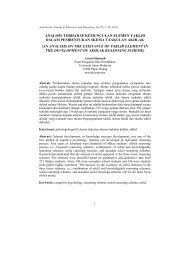
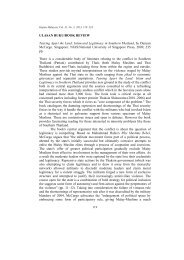

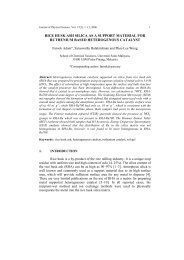

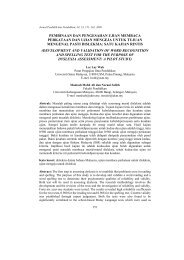
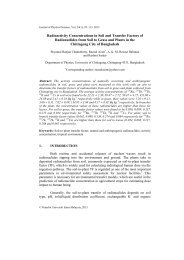
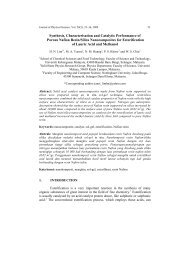

![KTT 111 – Inorganic Chemistry I [Kimia Takorganik I] - USM](https://img.yumpu.com/12405642/1/184x260/ktt-111-inorganic-chemistry-i-kimia-takorganik-i-usm.jpg?quality=85)
